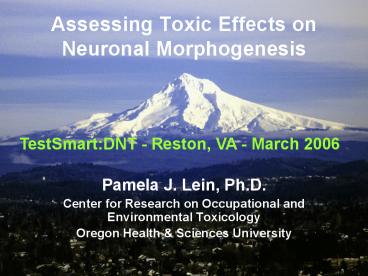Assessing Toxic Effects on Neuronal Morphogenesis - PowerPoint PPT Presentation
1 / 17
Title: Assessing Toxic Effects on Neuronal Morphogenesis
1
Assessing Toxic Effects on Neuronal Morphogenesis
TestSmartDNT - Reston, VA - March 2006
- Pamela J. Lein, Ph.D.
- Center for Research on Occupational and
Environmental Toxicology - Oregon Health Sciences University
2
Neuronal morphogenesis
3
Why study neuronal morphogenesis as an endpoint
in DNT?
The pattern of neural connections formed during
development determines the functional properties
of the vertebrate nervous system. Neuronal
morphogenesis determines neuronal connectivity.
4
What aspects of a neurons morphology determine
neuronal connectivity?
Axons Number, length, trajectory and
branching pattern Dendrites Number length,
trajectory and branching pattern Synapses
Number, size and distribution
5
In vitro model systems used to assess neuronal
morphogenesis
Neural cell lines (PC12, SH-SY) Primary
cultures of dissociated neurons /-
glia Organotypic slice cultures (CNS) or
ganglionic explants (PNS)
increasing complexity
6
Neural Cell Lines
Extend neurites that are neither axonal nor
dendritic Do not form synapses Predictive of
effects in vivo?
7
Primary cultures of dissociated neurons assessing
axonal growth
Control
Chlorpyrifos
Sympathetic neurons after 24 in vitro
immunostained for axonal marker
from Howard et al. (2005) Toxicol Appl Pharmacol.
207112-124
8
Primary cultures of dissociated neurons assessing
dendritic growth
dephosphorylated NF
MAP2
9
Primary Neuron-Glia Co-Cultures Sympathetic
neurons co-cultured with ganglionic glia
from Tropea et al., 1988 Glia 1380-392.
10
Activity increases dendritic growth in
hippocampal neurons in vitro
Wayman and Soderling, Vollum Institute, Portland,
OR
11
Phase
MAP-2
IFN? inhibits BMP-induced dendritic growth in
cultured sympathetic neurons
Control
BMP
IFN?
BMP IFN?
12
IFN? causes dendrite retraction in cultured
sympathetic neurons
IFN? added ?
Days of treatment
Kim et al., 2002, J. Neurosci. 224530-4549.
13
IFN?? decreases dendritic arborization of
sympathetic neurons in vivo
14
Primary cultures of dissociated neurons assessing
synaptogenesis
from Chih et al. (2005) Science 3071324-1328.
15
Organotypic slice culturesassessing neuronal
morphology
16
Major advantages of examining neuronal
morphogenesis in vitro systems vis á vis DNT
Relative simplicity facilitates detection of
subtle toxicant effects Immediate biological
relevance to developmental neurotoxicity experime
ntal and clinical evidence that disruption of
either the temporal or spatial aspects of axonal
or dendritic growth or synaptogenesis can cause
functional deficits Gene expression readily
manipulated and monitored
17
Potential difficulties in adapting in vitro
models of neuronal morphogenesis for DNT
Extrapolation across brain regions between
CNS and PNS between species Adaptation for high
through-put analysis Assessing contributions of
extraneural influences on developmental
neurotoxicity metabolism hormonal influences,
etc.)































